-

新人教版高中英语必修3Unit 3 Diverse Cultures教学设计一
Activity 81.Grasp the main idea of the listening.Listen to the tape and answer the following questions:Who are the two speakers in the listening? What is their relationship?What is the main idea of the first part of the listening? How about the second part?2.Complete the passage.Ask the students to quickly review the summaries of the two listening materials in activity 2. Then play the recording for the second time.Ask them to complete the passage and fill in the blanks.3.Play the recording again and ask the students to use the structure diagram to comb the information structure in the listening.(While listening, take notes. Capture key information quickly and accurately.)Step 8 Talking Activity 91.Focus on the listening text.Listen to the students and listen to the tape. Let them understand the attitudes of Wu Yue and Justin in the conversation.How does Wu Yue feel about Chinese minority cultures?What does Justin think of the Miao and Dong cultures?How do you know that?2.learn functional items that express concerns.Ask students to focus on the expressions listed in activity. 3.And try to analyze the meaning they convey, including praise (Super!).Agree (Exactly!)"(You're kidding.!)Tell me more about it. Tell me more about it.For example, "Yeah Sure." "Definitely!" "Certainly!" "No kidding!" "No wonder!" and so on.4.Ask the students to have conversations in small groups, acting as Jsim and his friends.Justin shares his travels in Guizhou with friends and his thoughts;Justin's friends should give appropriate feedback, express their interest in relevant information, and ask for information when necessary.In order to enrich the dialogue, teachers can expand and supplement the introduction of Miao, dong, Lusheng and Dong Dage.After the group practice, the teacher can choose several groups of students to show, and let the rest of the students listen carefully, after listening to the best performance of the group, and give at least two reasons.

新人教版高中英语必修3Unit 1 Festivals and Celebrations教学设计二
1. Ss look at the picture and scan the passage to understand the main idea while teacher is giving the following questions to inspire Ss to think.*Where are those people?*What are they doing?*Why are they so excited?2. Ss complete the passage with the appropriate -ing form. Then discuss and check the answers with class.Answers: boring, interesting, taking, exciting, amazing3. The teacher raises questions for the students to discuss and encourages them to express their opinions.*Do you like La Tomatina? Why or why not?4. Each group representative reports the discussion result, the teacher gives feedback and the evaluation.Step 6 PracticeActivity 41. Ss complete the Ex 2 in Using structures.2. Check the answers after finishing the exercises.①The dragon boat races are the most exciting part of the Dragon Boat Festival.② The children were excited to go Easter egg hunting.③What an amazing performance! This is the best music festival I have ever been to.④We were amazed by her funny-looking hat.⑤His inspiring speech at the conference won the admiration/ favour of the audience.⑥This is a challenging game to test your memory and observation capabilities. 3. T asks Ss to finish Ex 3 and 4 in Using structures by themselves, then check the answers with class.Step 6 Homework1. Understand and master the functions and usage of the -ing form;2. Finish the other exercises in Using structures.1、通过本节内容学习,学生是否理解和掌握动词-ing形式作定语和表语的功能和意义;2、通过本节内容学习,学生能否在理解文段内容的基础上,根据上下文语境和表达逻辑,能正确运用动词-ing形式描述节日庆典。3、通过本节内容学习,学生是否归纳和积累用于表达情绪的相关词汇。

新人教版高中英语必修3Unit 1 Festivals and Celebrations教学设计一
本板块的活动主题是“谈论节日活动”(Talk about festival activities),主要是从贴近学生日常生活的角度来切入“节日”主题。学生会听到发生在三个国家不同节日场景下的简短对话,对话中的人们正在参与或将要亲历不同的庆祝活动。随着全球化的进程加速,国际交流日益频繁,无论是国人走出国门还是外国友人访问中国,都已成为司空见惯的事情。因此,该板块所选取的三个典型节日场景都是属于跨文化交际语境,不仅每组对话中的人物来自不同的文化背景,对话者的身份和关系也不尽相同。1. Master the new words related to holiday: the lantern, Carnival, costume, dress(sb)up, march, congratulation, congratulate, riddle, ceremony, samba, make - up, after all. 2. To understand the origin of major world festivals and the activities held to celebrate them and the significance of these activities;3. Improve listening comprehension and oral expression of the topic by listening and talking about traditional festivals around the world;4. Improve my understanding of the topic by watching pictures and videos about different traditional festivals around the world;5. Review the common assimilation phenomenon in English phonetics, can distinguish the assimilated phonemes in the natural language flow, and consciously use the assimilation skill in oral expression. Importance:1. Guide students to pay attention to the attitude of the speaker in the process of listening, and identify the relationship between the characters;2. Inspire students to use topic words to describe the festival activities based on their background knowledge. Difficulties:In the process of listening to the correct understanding of the speaker's attitude, accurately identify the relationship between the characters.

新人教版高中英语必修3Unit 2 Morals and Virtues教学设计二
Activity 41. Students complete the task of activity 4, then teachers and students check the answers. 2. The teacher organized the students to work together and asked them to use the tables and mind maps sorted out before to retold the important choices in Lin Qiaozhi's life and their resultsStep 5 Language points1. The teacher asks the students to read the text carefully, find out the core words and long and difficult sentences in the text and draw lines, understand the use of vocabulary, and analyze the structure of long and difficult sentences. 2. The teacher explains and summarizes the usage of core vocabulary and asks the students to take notes. 3. The teacher analyzes and explains the long and difficult sentences that the students don't understand, so that the students can understand them better. Step 6 Homework1. Read the text again, in-depth understanding of the text; 2. Master the use of core vocabulary and understand the long and difficult sentences. 3. Complete relevant exercises in the guide plan. 1、通过本节内容学习,学生是否理解和掌握阅读文本中的新词汇的意义与用法;2、通过本节内容学习,学生能否结合文本特点总结林巧稚的人生原则和人格品质特征;3、通过本节内容学习,学生能否针对人生抉择发表自己的看法;能否全面地、客观地、理性地看待问题,进而对道德和人性有更加深入的思考和理解。

新人教版高中英语必修3Unit 1 Festivals and Celebrations教学设计三
*wide range of origins(= a great number of different origins, many kinds of origins)*It featured a parade and a great feast with music, dancing, and sports. (=A parade and a great feast with music, dancing, and sports were included as important parts of the Egyptian harvest festival.)*.. some traditions may fade away and others may be established.(= Some traditions may disappear gradually, while other new traditions may come into being.)Step 6 Practice(1) Listen and follow the tape.The teacher may remind the students to pay attention to the meaning and usage of the black words in the context, so as to prepare for the completion of the blanks in activity 5 and vocabulary exercises in the exercise book.(2) Students complete the text of activity 5 by themselves.The teacher needs to remind the students to fill in the blanks with the correct form of the vocabulary they have learned in the text.Students exchange their answers with their partners, and then teachers and students check their answers.(3)Finish the Ex in Activity 5 of students’ book.Step 7 Homework1. Read the text again, in-depth understanding of the text;2. Discuss the origin of festivals, the historical changes of related customs, the influence of commercial society on festivals and the connotation and essential meaning of festivals.3. Complete relevant exercises in the guide plan.1、通过本节内容学习,学生是否理解和掌握阅读文本中的新词汇的意义与用法;2、通过本节内容学习,学生能否结合文本特点快速而准确地找到主题句;3、通过本节内容学习,学生能否理清论说文的语篇结构和文本逻辑,了解节日风俗发展与变迁,感悟节日的内涵与意义。

新人教版高中英语必修3Unit 2 Morals and Virtues教学设计三
The joke set her crying.这个玩笑使她哭起来。Step 5 ReadingActivity 31. Students read the small text in activity 3. The teacher provides several small questions to check whether students understand the content of the text and the ideographic function of the -ing form in the text.*Where are those people?*Why did Dr Bethune come to China?*How did he help the Chinese people during the war?*What did Chairman Mao Zedong say about him?2. Ss try to rewrite some sentences using the -ing form. Then check the answers. When checking the answers, the teacher can ask different students to read the rewritten sentences and give comments.Answers:1. he became very interested in medicine, deciding to become a doctor.2. …after hearing that many people were dying in the war.3. Helping to organise hospitals, he taught doctors and nurses, and showed people how to give first aid./ He helped to organise hospitals, teaching doctors and nurses, and showing people how to give first aid.4. …praising Dr Bethune as a hero to be remembered in China.Step 6 PracticeActivity 4Students complete grammar activities 2 and 3 on page 69 of the workbook.Step 6 Homework1. Understand and master the functions and usage of the -ing form;2. Finish the other exercises in Using structures.1、通过本节内容学习,学生是否理解和掌握动词-ing形式作宾语补足语语和状语语的功能和意义;2、通过本节内容学习,学生能否正确使用动词-ing形式描述人物的行为、动作及其经历;3、通过本节内容学习,学生能否独立完成练习册和导学案中的相关练习。

新人教版高中英语必修3Unit 2 Morals and Virtues教学设计四
3.Teachers ask different groups to report the answers to the questions and ask them to try different sentence patterns.The teacher added some sentence patterns for students to refer to when writing.Step 4 Writing taskActivity 51.Write the first draft.Students first review the evaluation criteria in activity 5, and then independently complete the draft according to the outline of activity 4, the answers to the questions listed in the group discussion and report, and the reference sentence pattern.2.Change partners.The teacher guides the students to evaluate their partner's composition according to the checklist of activity 5 and proposes Suggestions for modification.3.Finalize the draft.Based on the peer evaluation, students revise their own compositions and determine the final draft.Finally, through group recommendation, the teacher selects excellent compositions for projection display or reading aloud in class, and gives comments and Suggestions.Step 5 Showing writingActivity 5T call some Ss to share their writing.Step 6 Homework1. Read the passage in this section to better understand the passage.2. Carefully understand the hierarchical structure of the article, and deeply understand the plot of the story according to the causes, process and results;3. Independently complete the relevant exercises in the guide plan.1、通过本节内容学习,学生是否理解和掌握阅读文本中的新词汇的意义与用法;2、通过本节内容学习,学生能否通过人物言行的对比分析道德故事的深层内涵;3、通过本节内容学习,学生能否根据故事的起因、经过和结果来深入理解故事的情节,从而了解文章的层次结构;4、结合现实生活案例发表自己的见解和看法,写一篇观点明确、层次分明的故事评论。

新人教版高中英语必修3Unit 2 Morals and virtues教学设计一
(2) students are divided into groups according to the requirements of activity 3. Each student shares a story of personal experience or hearing-witnessing kindness, and then selects the most touching story in the group and shares it with the whole class. Before the students share the story, the teacher can instruct them to use the words and sentence patterns in the box to express. For example, the words in the box can be classified:Time order: first of all, then, after that, later, finally logical relationship :so, however, although, butTeachers can also appropriately add some transitional language to enrich students' expression:Afterwards, afterwards, at last, in the end, eventuallySpatial order: next to, far from, on the left, in front ofOtherwise, nevertheless, as a result, therefore, furthermore, in addition, as well asSummary: in a word, in short, on the whole, to sum up, in briefStep 8 Homework1. Understand the definition of "moral dilemma" and establish a correct moral view;2. Accumulate vocabulary about attitudes and emotions in listening texts and use them to express your own views;3. Complete relevant exercises in the guide plan.1、通过本节内容学习,学生能否理解理解“道德困境”的定义;2、通过本节内容学习,学生能否通过说话人所表达的内容、说话的语气、语调等来判断其态度和情绪;3、通过本节内容学习,学生能否针对具体的道德困境发表自己的看法和见解,能否掌握听力理训练中的听力策略。
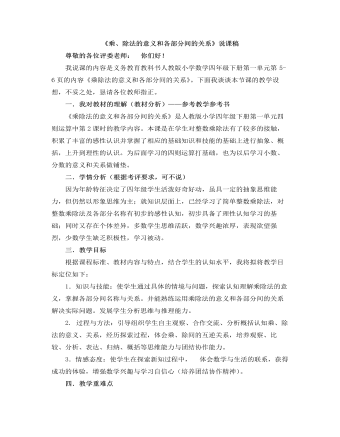
小学数学人教版四年级下册《乘、除法的意义和各部分间的关系》说课稿
尊敬的各位评委老师: 你们好!我说课的内容是义务教育教科书人教版小学数学四年级下册第一单元第5-6页的内容《乘除法的意义和各部分间的关系》。下面我谈谈本节课的教学设想,不妥之处,恳请各位教师指正。一.我对教材的理解(教材分析)——参考教学参考书《乘除法的意义和各部分间的关系》是人教版小学四年级下册第一单元四则运算中第2课时的教学内容。本课是在学生对整数乘除法有了较多的接触,积累了丰富的感性认识并掌握了相应的基础知识和技能的基础上进行抽象、概括,上升到理性的认识。为后面学习的四则运算打基础,也为以后学习小数、分数的意义和关系做铺垫。二.学情分析(根据考评要求,可不说)因为年龄特征决定了四年级学生活泼好奇好动,虽具一定的抽象思维能力,但仍然以形象思维为主;就知识层面上,已经学习了简单整数乘除法,对整数乘除法及各部分名称有初步的感性认知,初步具备了理性认知学习的基础;同时又存在个体差异,多数学生思维活跃,数学兴趣浓厚,表现欲望强烈,少数学生缺乏积极性,学习被动。
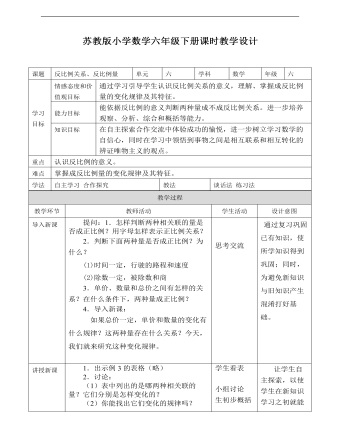
小学数学苏教版六年级下册《第六单元第三课反比例关系、反比例量》教学设计说课稿
提问:1.怎样判断两种相关联的量是否成正比例?用字母怎样表示正比例关系? 2.判断下面两种量是否成正比例?为什么? (1)时间一定,行驶的路程和速度 (2)除数一定,被除数和商 3.单价、数量和总价之间有怎样的关系?在什么条件下,两种量成正比例? 4.导入新课: 如果总价一定,单价和数量的变化有什么规律?这两种量存在什么关系?今天,我们就来研究这种变化规律。

【高教版】中职数学基础模块上册:1.2《集合之间的关系》优秀教案
学科数学 课 题 1.2 集合之间的关系班级 人数 授课时数2 课 型新课 周次 授课时间 教 学 目 的 知识目标:(1)掌握子集、真子集的概念; (2)掌握两个集合相等的概念; (3)会判断集合之间的关系. 能力目标:培养学生的分析问题能力解决问题的能力. 情感目标:通过师生互动,学生之间的讨论分析,加强合作意识。 教学重点集合与集合间的关系及其相关符号表示. 教学难点真子集概念的理解.

北师大初中数学八年级上册数据的离散程度1教案
(4)从平均分看,两队的平均分相同,实力大体相当;从折线的走势看,甲队比赛成绩呈上升趋势,而乙队比赛成绩呈下降趋势;从获胜场数看,甲队胜三场,乙队胜两场,甲队成绩较好;从方差看,甲队比赛成绩比乙队比赛成绩波动小,甲队成绩较稳定.综上所述,选派甲队参赛更能取得好成绩.方法总结:本题是反映数据集中程度与离散程度的综合题.从图形中得到两队的成绩,然后从平均数、方差的角度来考虑,在平均数相同的情况下,方差越小的越稳定.三、板书设计数据的离散程度极差:一组数据中最大数据与最小数据的差方差:各个数据与平均数差的平方的平均数 s2=1n[(x1-x)2+(x2-x)2+…+(xn-x)2]标准差:方差的算术平方根 公式:s=s2经历表示数据离散程度的几个量的探索过程,通过实例体会用样本估计总体的统计思想,培养学生的数学应用能力.通过小组合作,培养学生的合作意识;通过解决实际问题,让学生体会数学与生活的密切联系.
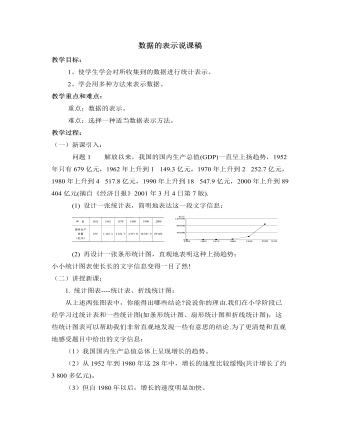
北师大初中数学七年级上册数据的表示说课稿
(1) 这28天中属于“重度染污”、“中度污染”、“轻度污染”、“良”和“优”的天数各有几天?出现的频率各是多少?请用一张统计表来表示;(3) 从你作的统计图表中,你得到哪些结论?说说你的理由.(三)课堂小结:本节课学习了用统计来直观来表示数据,并从统计图中发现数据间的联系。整理数据——制统计表1、从资料给出的许多数据中选取相关数据进行整理;2、标目分成横、纵两种(允许不同分法);3、把数据放入相应位置。为了更清晰地用统计表展示与描绘数据,统计表必须有规范的结构:标题(统计表的名称)标目(如“国家”、“届数”…)数据、必要的说明(数据的单位、制表日期等)折线统计图的步骤:(1)写出统计图名称;(2)画出横、纵两条互相垂直的数轴(有时不画箭头),分别表示两个标目的数据;(3)根据横、纵各个方向上的各对对应的标目数据画点;(4)用线段把每相邻两点连接起来。
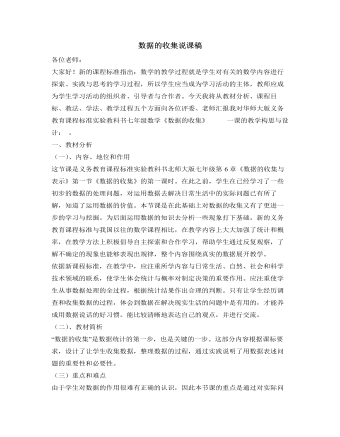
北师大初中数学七年级上册数据的收集说课稿
一、教材分析(一)、内容、地位和作用这节课是义务教育课程标准实验教科书北师大版七年级第6章《数据的收集与表示》第一节《数据的收集》的第一课时。在此之前,学生在已经学习了一些初步的数据的处理问题,对运用数据去解决日常生活中的实际问题已有所了解,知道了运用数据的价值。本节课是在此基础上对数据的收集又有了更进一步的学习与挖掘。为后面运用数据的知识去分析一些现象打下基础。新的义务教育课程标准与我国以往的数学课程相比,在教学内容上大大加强了统计和概率,在教学方法上积极倡导自主探索和合作学习,帮助学生通过反复观察,了解不确定的现象也能够表现出规律,整个内容围绕真实的数据展开教学。依据新课程标准,在教学中,应注重所学内容与日常生活、自然、社会和科学技术领域的联系,使学生体会统计与概率对制定决策的重要作用。
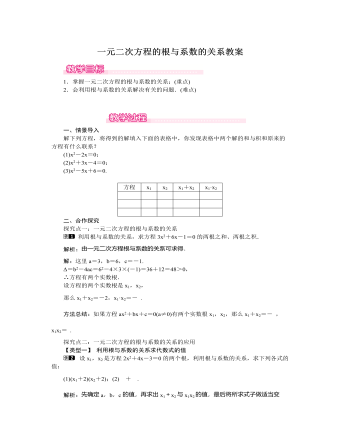
北师大初中数学九年级上册一元二次方程的根与系数的关系1教案
方程有两个不相等的实数根.综上所述,m=3.易错提醒:本题由根与系数的关系求出字母m的值,但一定要代入判别式验算,字母m的取值必须使判别式大于0,这一点很容易被忽略.三、板书设计一元二次方程的根与系数的关系关系:如果方程ax2+bx+c=0(a≠0) 有两个实数根x1,x2,那么x1+x2 =-ba,x1x2=ca应用利用根与系数的关系求代数式的值已知方程一根,利用根与系数的关系求方程的另一根判别式及根与系数的关系的综合应用让学生经历探索,尝试发现韦达定理,感受不完全的归纳验证以及演绎证明.通过观察、实践、讨论等活动,经历发现问题、发现关系的过程,养成独立思考的习惯,培养学生观察、分析和综合判断的能力,激发学生发现规律的积极性,激励学生勇于探索的精神.通过交流互动,逐步养成合作的意识及严谨的治学精神.
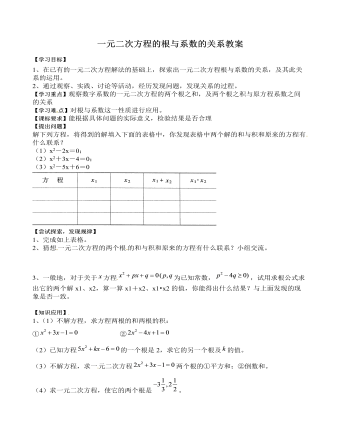
北师大初中数学九年级上册一元二次方程的根与系数的关系2教案
3、一般地,对于关于 方程 为已知常数, ,试用求根公式求出它的两个解x1、x2,算一算x1+x2、x1?x2的值,你能得出什么结果?与上面发现的现象是否一致。【知识应用】 1、(1)不解方程,求方程两根的和两根的积:① ② (2)已知方程 的一个根是2,求它的另一个根及 的值。(3)不解方程,求一 元二次方程 两个根的①平方和;②倒数和。(4)求一元二次方程,使它的两个根是 。【归纳小结】【作业】1、已知方程 的一个根是1,求它的另一个根及 的值。2、设 是方程 的两个根,不解方程,求下列各式的值。① ;② 3、求一个一元次方程,使它的两 个根分别为:① ;② 4、下列方程两根的和与两根的积各是多少 ?① ; ② ; ③ ; ④ ;
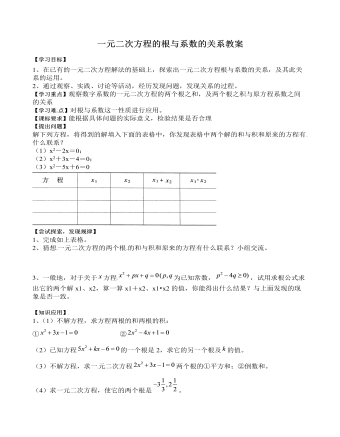
北师大初中数学九年级上册一元二次方程的根与系数的关系2教案
2、猜想 一元二次方程的两个根 的和与积和原来的方程有什么联系?小组交流。3、一般地,对于关于 方程 为已知常数, ,试用求根公式求出它的两个解x1、x2,算一算x1+x2、x1?x2的值,你能得出什么结果?与上面发现的现象是否一致。【知识应用】 1、(1)不解方程,求方程两根的和两根的积:① ② (2)已知方程 的一个根是2,求它的另一个根及 的值。(3)不解方程,求一 元二次方程 两个根的①平方和;②倒数和。(4)求一元二次方程,使它的两个根是 。【归纳小结】【作业】1、已知方程 的一个根是1,求它的另一个根及 的值。2、设 是方程 的两个根,不解方程,求下列各式的值。① ;② 3、求一个一元次方程,使它的两 个根分别为:① ;② 4、下列方程两根的和与两根的积各是多少 ?① ; ② ; ③ ; ④ ;

人教版高中地理必修2人地关系思想的演变精品教案
生1:公平性原则——同代人之间要公平,代际之间、人类与其他生物种群之间、不同国家与地区之间也要公平。生2:持续性原则——地球的承载力是有限的,人类的经济活动和社会发展必须保持在资源和环境的承载力之内。生3:共同性原则——发展经济和保护环境是全世界各国共同的任务,需要各国的共同参与。同时,地球作为一个整体,地区性问题往往会变为全球性问题,所以地区的决策和行动,应有助于实现全球整体的协调。活动与探究:2·阅读下面一篇新闻报道,你认为“给蛇让道”有没有必要?答:有必要·人类在森林区内修筑公路,已经侵占和破坏了蛇的生存环境,如果再不对蛇的迁移进行保护,蛇数量的减少以至灭绝将不可避免。这种做法体现了可持续发展的公平性原则和共同性原则。3·用可持续发展的观念作为衡量标准,对下列观点作出评价。(1)人类有义务保护地球上所有的物种,人类的发展不应该危及其他物种的生存。答:正确。符合可持续发展的公平性原则。
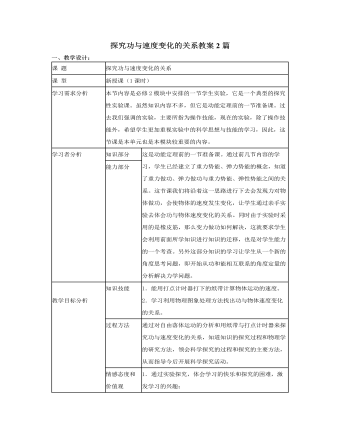
人教版新课标高中物理必修2探究功与速度变化的关系教案2篇
说明:“倍增法”是一种重要的物理方法,历史上库仑在研究电荷间的相互作用力时曾用过此法,但学生在此前的物理学习中可能未曾遇到类似例子,因此引导学生通过交流,领会“倍增法”的妙处,这是本节课的一个要点.可用体育锻炼中的“拉力器”来类比。(2)该方案消除摩擦力影响的方法:所用的消除方法与实验方案2一样。也可使用气垫导轨代替木板,以更好地消除摩擦影响。(3)小车速度的确定方法:①确定打出来的点大致呈现什么规律:先密后疏(变加速),再均匀分布(匀速);②应研究小车在哪个时刻的速度:在橡皮筋刚恢复原长时小车的瞬时速度,即纸带上的点刚开始呈现均匀分布时的速度;③应如何取纸带上的点距以确定速度:由于实验器材和每次操作的分散性,尤其是橡皮筋不可能长度、粗细完全一致,使得每次改变橡皮筋的条数后,纸带上反映小车匀速运动的点数和点的位置,不一定都在事先的设定点(即用一条橡皮筋拉小车,橡皮筋刚好恢复原长时纸带上的点)处。
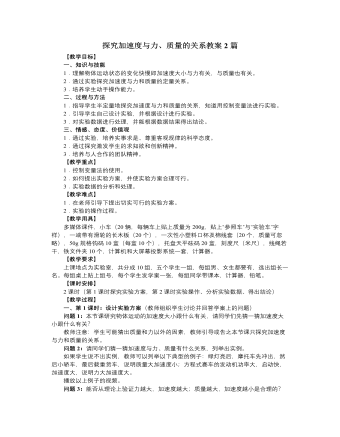
人教版新课标高中物理必修1探究加速度与力、质量的关系教案2篇
三、制定实验方案的两个问题:1.怎样测量(或比较)物体的加速度:引导学生思考、讨论并交流。学生可能会提出下面的一些方案:方法一:测出初速度为零的匀加速直线运动的物体在 时间内的位移 ,则 ;方法二:在运动的物体上安装一条打点计时器的纸带,根据纸带上打出的点来测量加速度;方法三:测出两个初速度为零的匀加速运动的物体在相同的时间内发生的位移 、 ,则 ;方法四:测出两个初速度为零的匀加速运动的物体在相同的位移内所用的时间 、 ,则 ;2.怎样提供并测量物体所受的恒力:教师提出:现实中,除了在真空中抛出或落下的物体(仅受重力)外,仅受一个力的物体几乎是不存在的。然而,一个单独的力作用效果与跟它大小、方向都相同的合力的作用效果是相同的,因此,实验中力 的含义指物体所受的合力。以在水平轨道上用绳牵引小车加速运动为例,小车受到四个力的作用,即重力、支持力、绳的拉力和轨道对小车的摩擦力(当物体运动的速度比较小时,我们可以忽略空气的阻力)。